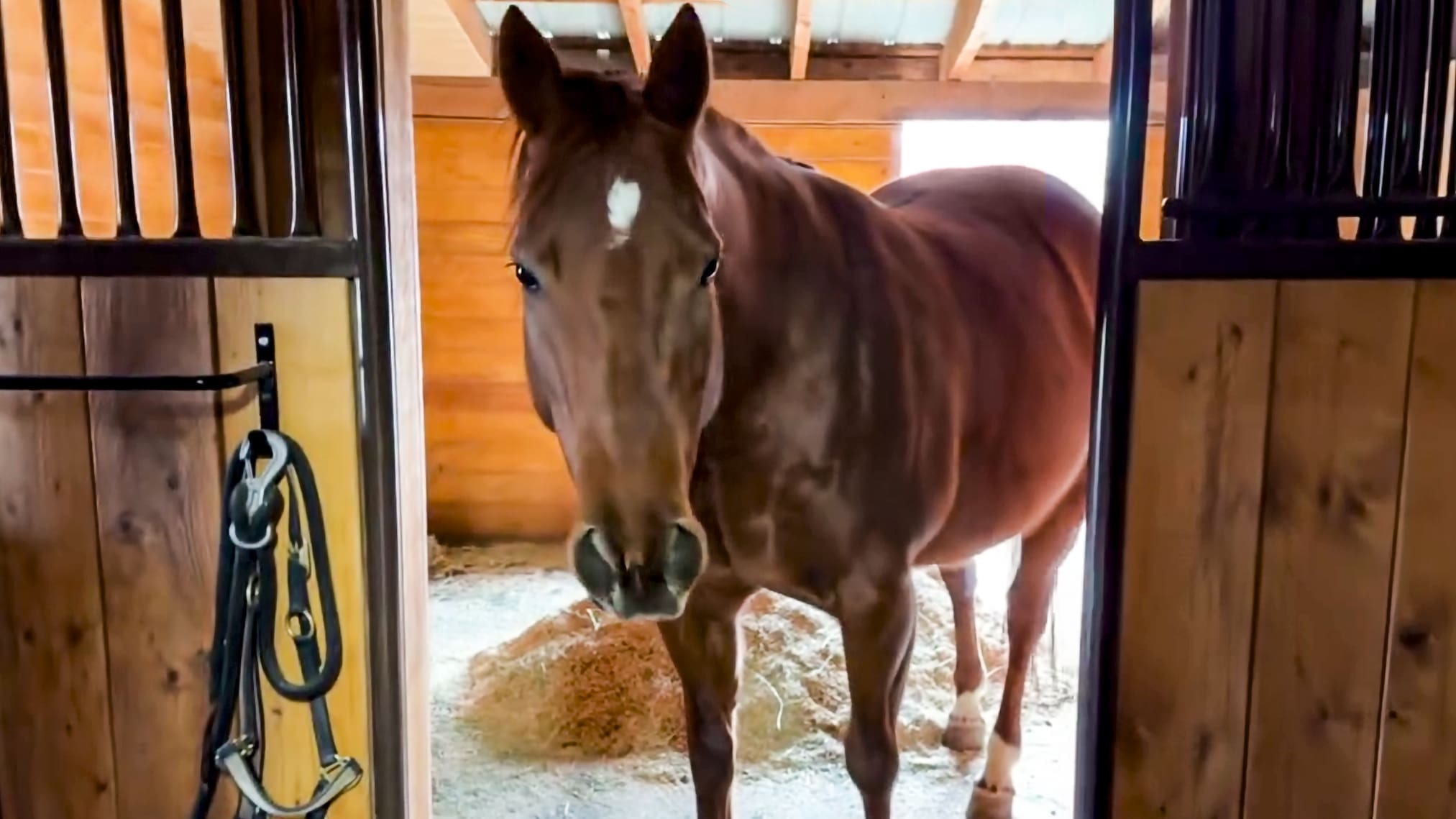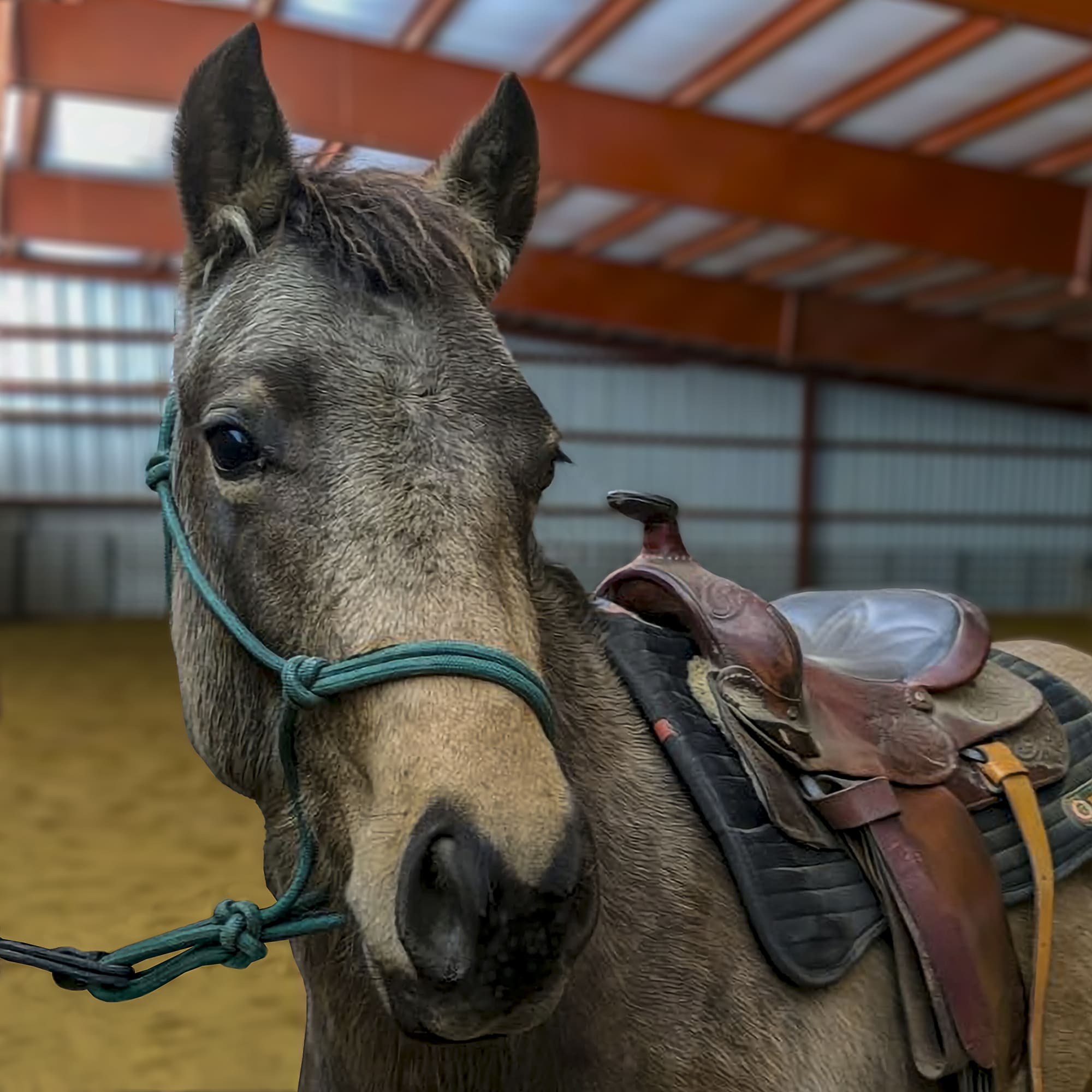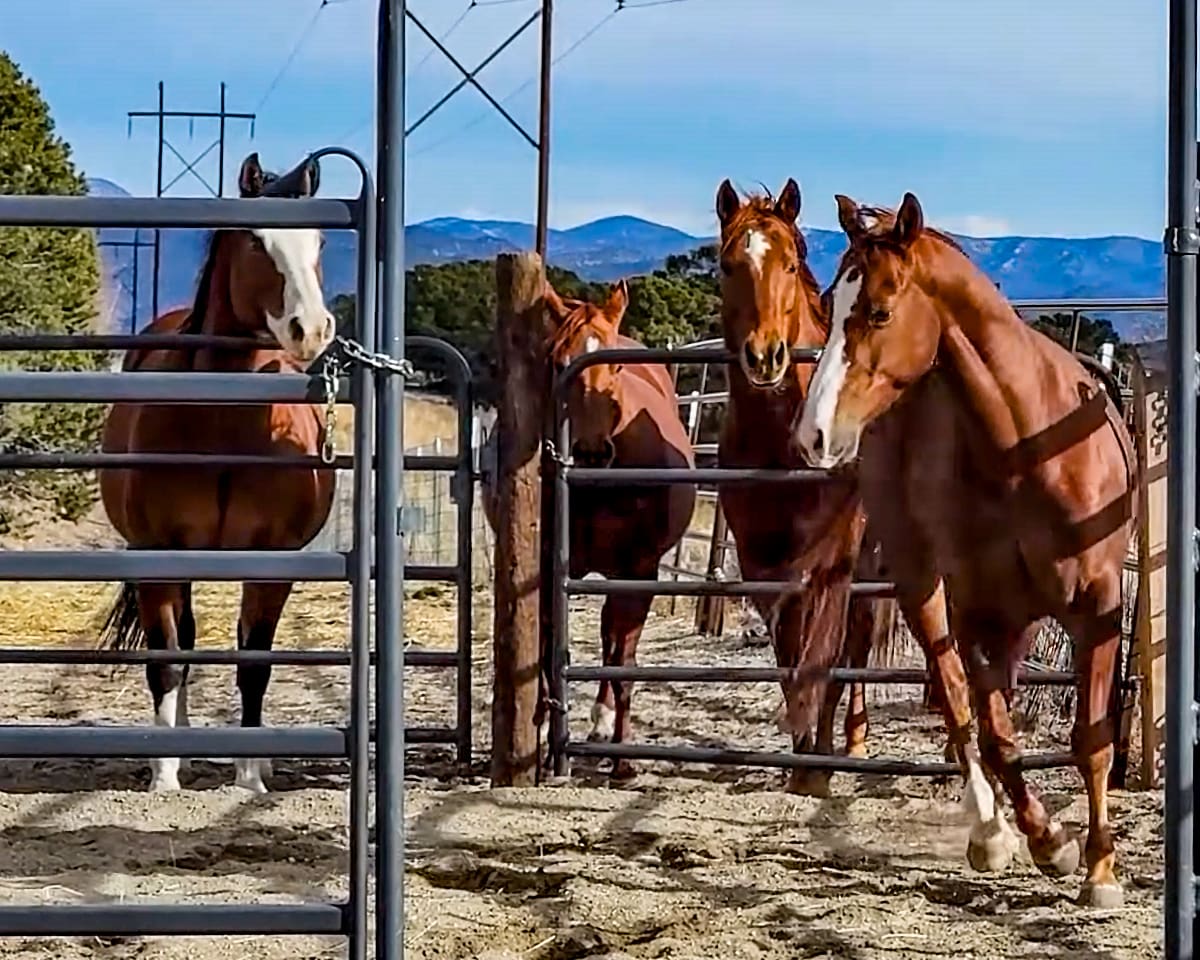Sit the Spook
Learn how to sit the spook on trail for safety and control with top trainer/clinician Julie Goodnight.
All horses are capable of spooking. Horses are hardwired to flee in response to fear. They’re naturally programmed to watch for danger and for the herd leader’s cue for when to bolt.
Get away first; think later.
While you can desensitize your horse to most any stimulus you may encounter on the trail (and you should), there’s always a chance he’ll see something new, scary, and spook inducing.
“I laugh when I see sale ads boast a ‘bombproof’ horse that will never spook,” says top trainer/clinician Julie Goodnight.
Of course, horses are individuals and some may spook more often than others. Put the word “never” in there, and horses will prove you wrong.
Arabian Horses are stereotyped to be more flighty than Quarter Horses, but there are individuals who prove the stereotype wrong for each breed.
Quarter Horses bred for cow work may see a slight movement and look for something to chase.
You can’t totally remove the spook from the horse (though you should desensitize him as much as you can), but you can program your brain to know what to do in the moment when your horse spooks. You’re the part of the equation that can change.
A great trail-riding horse doesn’t need to be “bombproof” if you prepare your mind and body.
Here, Goodnight will give you her six-step method on how to sit the spook: (1) Envision perfection; (2) relax; (3) sit well; (4) be the herd leader; (5) react quickly; (6) convert his behavior.
Goodnight will also provide a special riding exercise just for kids.
Step 1: Envision Perfection
Is your horse tense on the trail? Envision your horse as well-behaved and calm, and ride him in a way that lets him know you’re in charge.
Don’t allow your horse to look around and find something to spook at. He doesn’t need to look from side-to-side and take in the scenery. His job is to look at what’s in front of him and mind the footing.
You’re in charge of where your horse looks. His nose shouldn’t move beyond the width of his shoulders. Looking straight ahead is the obedient response.
Ride with two hands. If he turns his head to look at the scary bushes, wildlife, etc., bump his nose back to center with light rein pressure.
Avoid gripping the reins tightly. Keep the reins loose, so your horse doesn’t feel your anxiety and think he should be worried. But don’t allow too much rein slack. You’ll need to have enough contact available to turn your horse if he reacts to something scary. (More on that in a minute.)
If your horse is tense, calm him by showing him you’re a worthy leader. Get him moving, and give him something to do. You don’t have to ride in a straight line. Guide him to the right and left; go around a bush.
Turning in different directions will get your horse thinking and give you control. Control his space, and remind him that you’re in charge of where you both go.
Step 2: Relax
Relaxing can be a tall order — especially if you think your horse might spook. To relax, close your eyes momentarily, and picture a balanced rider. Assume a centered, balanced position, with your ear, shoulder, hip, and heel in alignment.
Then systematically relax every joint in your body. Imagine relaxed toes. Unlock your knees. Relax your hips, and move with your horse’s back. Drop your shoulders. Unclench your fingers, wrists, hands, and shoulders.
If you’re worried that your horse might spook and become uncontrollable, you’ll probably tense your hips, clamp your legs, and grasp at the reins. You might even go into the fetal position.
These are normal reflexes in response to fear — your body pulls into the center for protection. But when you’re riding, this isn’t a safe posture at all.
Rolling into a ball causes you to pull on the reins, and drive your heels and legs into your horse’s sides. These actions tell him to be worried and move quickly — so you’re actually cueing him to spook.
What’s more, when you’re worried, you tense up your joints, locking them into position — a dangerous riding posture.
Tense a bicep as though you’re showing off your arm muscles. Notice that when you do so, your wrist elbow and shoulder joints lock.
Responding to a spook by tensing up and locking your joints is like hitting an ejection button. When you stiffen your back, shoulders, and legs, your body becomes one tense, locked object that can’t move with your horse. Instead, you’ll likely to bounce right off.
Step 3: Sit Well
On the other hand, you can be too relaxed, riding with your feet out in front of you, as though you’re sitting in a recliner with a remote control in your hand.
This isn’t a balanced position. If your horse spooks, you won’t have time to regain your balance to correct him, and you’ll likely be left behind.
Do you lengthen your stirrups for trail riding because it seems more comfortable? Don’t think you can ride with too-long stirrups because you’re “just trail riding.” Let’s take “just trail riding” out of the vocabulary.
Choose a stirrup length that allows your feet to rest without reaching — and while keeping your knees slightly bent so you can move like an athlete. Also, make sure your legs will stay underneath your seat.
Instead of sitting far back in the saddle, maintain an active, athletic stance. Suck in your belly button, rock back on your pockets, and sink your heels deep into the stirrups.
For a balanced, anchored position, ride with your toes up and heels down. Roll your ankles so that the bottoms of your feet are angled away from your horse.
Rolling in your ankles and slightly lifting your pinky toes move your legs into a close contact position and wraps the stirrup leathers around your legs.
There’s a yoga term that will help you imagine sitting up, back, and in balance: back body. Ride with your back body extended. That is, lengthen all your back’s bones, ligaments, and “energy.”
Almost everything in life causes you to cock your chest and abdomen forward and lock your hips, that is, living in the front body. Think hunching over the computer or slouching on the couch.
In riding, you want to elongate your back body and be conscious of your back. Relax and round your lower back, and extend your torso up; shorten your front-side and lengthen your back-side.
Stay in your back body, and don’t allow your energy to move forward. Use this visualization to prepare for riding — and prepare for a spook.
Step 4: Be the Herd Leader
Your horse is a herd animal, wired to notice the reactions and tension of the herd members. When you ride your horse, you’re in his herd, so he looks to you to make sure everything is okay. Imagine yourself as a strong, calm leader.
If you even think your horse might spook, start deep, abdominal breathing. He’ll detect if you’re holding your breath, which signals to him that he should be afraid.
Breathing with purpose will extend your spine and help you think about riding in your back body. Breathing is critical. Do it. Air is free.
Moving your eyes will help keep your whole body relaxed. Your horse will notice your tension if you lock your gaze on something you think may spook him.
Focus where you want your horse to go — not at something that’s potentially scary. When you focus on where you are now or where your horse is going, your eyes lend weight and point your body to that point.
What’s more, when you turn and look at where your horse is headed, instead of where you want to go, the problem gets worse.
Let’s say your horse spooks at something to the right of the trail and that’s what he’s moving away from. But you’re more afraid of the drop-off to the left of the trail that he’s moving toward — so you look left.
Your horse usually goes where you look or follows your focus. So by looking the wrong way, you’ve encouraged him to spook. Instead, focus where you want to go so that everything in your body gives him a consistent cue to go where you want.
Step 5: React Quickly
When your horse spooks, you won’t have time to stop and think. Spooks happen fast. You’ll only have an instant to stop your horse’s desire to bolt and focus him on the path you want.
This is the time that your at-home, in-the-car, thinking-ahead mental practice comes into play. Here’s a breakdown of what happens during a spook and how you’ll need to respond to keep your horse from bolting — all while keeping yourself relaxed, in your back body, breathing, and looking where you want to go.
In a spook, your horse first turns in the opposite direction of the scary object and tries to get away from it. He’s acting on his deep-seated flight instinct to survive.
Get in your mind that you’ll always turn your horse back toward the spooky stimulus any time he spooks. Lock in that image. Practice the motions and scenario over and over. Facing fear countermands flight.
Your horse will never run toward the spook-inducing stimulus, so a turn is required. Be prepared to turn with one rein. This flexes his neck and encourages the turn. Then ask for the stop.
If you pull on both reins at once, your horse will run right through the reins, and you’ll be in a pound-for-pound battle you can’t win.
If you shut off his escape path, he’ll try to turn another way. Be prepared to turn to the right then to the left with one rein while avoiding putting any pressure on the opposite rein. Block each escape path, and point him back at the scary stimulus. He won’t bolt toward what he’s afraid of.
The further your horse gets into the flight response before you intervene, the harder it is to get him out of the bolting run. Your reaction has to be quick. You might have to take a sudden, hard hold of your horse so that you can stop him before he bolts too far. If he gets four or five strides into the bolt, you may not be able to stop him.
As soon as you turn and stop your horse from bolting, he should stop and look at what scared him. Program in this response by approaching scary objects at home. Praise your horse each time he stops and looks at the scary object.
Repetition locks in this response and will help you on the trail. You can’t take the spook out of your horse, but you can teach him how to deal with it.
During a spook on the trail, your horse may be so scared that he won’t be ready to stop and will instead turn away again. Each time he turns, block his path. By doing so, you’ll leave him no other option but to face his fear.
As your horse calms, ask him to stop again. Encourage him to take a breath by taking a deep breath yourself. When you eliminate his flight option, he’ll calm down and listen to your cues. Soften your body, and sigh out the air. Pet him on the neck. Let him know you’re the leader in your herd of two and that all is okay.
If your horse flies backward, chances are, you’re pulling back on the reins. Note that pulling back on the reins doesn’t stop your horse. In fact, it may be causing the problem.
Instead, reach your hands straight toward your horse’s ears, and pump your legs on him from behind the cinch.
If you can’t stop the backward motion, pick up one rein toward your opposite shoulder, and cause him to cross his back legs. He can’t back and cross his legs at the same time. (You might want to practice this at home.)
Step 6: Convert his Behavior
When your horse determines that the scary monster isn’t going to kill and eat him, he’ll “convert” to investigative behavior. Investigative behavior is simply curiosity and will cancel out his flight behavior.
If your horse moves forward toward the scary thing, allow him to check it out, and praise him. This will convert him — replace one natural behavior with another without getting into a fight.
When your horse is curious about what spooked him, he’s suddenly brave. He’ll want to go closer. Praise him for his courageous actions, look for a new location to ride toward, and move down the trail.
For more information on equine behavior, see Goodnight’s Guide to Great Trail Riding, with bonus DVD at Shop.JulieGoodnight.com
This article first appeared in The Trail Rider ~ September/October 2014




No comment yet, add your voice below!